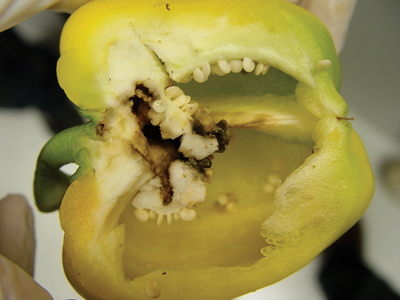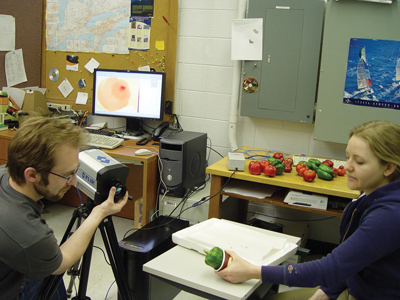
For researchers studying a difficult-to-detect problem with greenhouse
peppers, a picture might indeed be worth a thousand words.
For researchers studying a difficult-to-detect problem with greenhouse peppers, a picture might indeed be worth a thousand words.
 |
|
| A pepper with European corn borer damage. Advertisement
|
Dr. Ray Cerkauskas, of the Greenhouse and Processing Crops Research Centre (GPCRC), is part of a team hoping highly sensitive thermal imaging photography can identify greenhouse peppers infected with European corn borer. The problem is that such peppers have no visible symptoms.
Also involved on the project are GPCRC colleague Dr. David Hunt, and Dr. Roman Maev of the Department of Physics at the University of Windsor. Dr. Maev is one of Canada’s leading thermal imaging experts. The camera captures temperature differences of a tenth of a degree.
“By using thermal images,” explains Cerkauskas, “we’re hoping to detect differences between infested and non-infested fruit.”
 |
|
| Thermal imaging of seeds, with monitor in background |
The project is also looking at soybeans.
“If I touch a leaf, I will leave a thermal print that will dissipate over a period of time.” However, thanks to thermal photography, “you can see differences in colour that are related to temperature.”
Assisting him is University of Windsor student Jacqueline Gilmet, whose work is funded through the Federal Public Sector Youth Internship Program (FPSYIP).
YELLOW STEM WITH GREENHOUSE TOMATOES
Cerkauskas is continuing pathogenicity testing to determine the causal agent of Yellow Stem disease found in some late-season tomato crops. “Growers have noticed over the past couple of years that some of the older plants would have a more prominent yellow stem.”
Such plants experience a decline in yields.
The disease is caused by a species of fusarium. It’s a latent infection in which symptoms don’t develop for many months.
His research team is also determining whether Yellow Stem can also infect greenhouse cucumber plants.
REDUCED RISK MATERIALS IN PHYTOPHTHORA CONTROL
Phytophthora blight has been a problem in field vegetable crops in the U.S., including several states bordering Ontario. Most affected are tomatoes, peppers and cucurbits. It potentially could be an issue for Ontario growers, though there have only been some isolated cases in the province in recent years. Because it is a fungal disease that thrives in warm and wet conditions, greenhouse grow bags would be an ideal site for Phytophthora capsici.
To ensure a quick response by Canadian growers should it become an issue, Dr. Cerkauskas and his team have spent considerable time studying reduced risk materials.
“We have completed research with chemical control of Phytophthora capsici in greenhouse tomato, cucumber and pepper crops. We found a number of chemicals to be effective.”
All three projects are in collaboration with Gillian Ferguson, the OMAFRA greenhouse pest management specialist. They seek to solve the immediate practical needs of the greenhouse vegetable industry. ■
Print this page